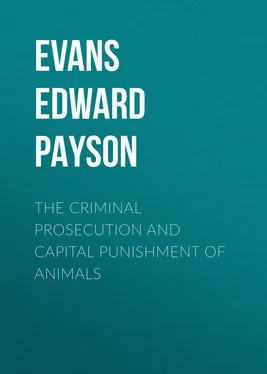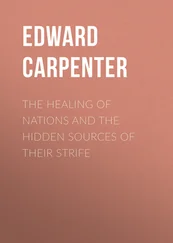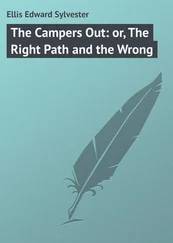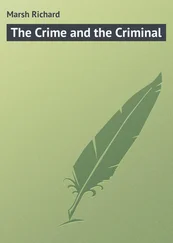Edward Evans - The Criminal Prosecution and Capital Punishment of Animals
Здесь есть возможность читать онлайн «Edward Evans - The Criminal Prosecution and Capital Punishment of Animals» — ознакомительный отрывок электронной книги совершенно бесплатно, а после прочтения отрывка купить полную версию. В некоторых случаях можно слушать аудио, скачать через торрент в формате fb2 и присутствует краткое содержание. Жанр: foreign_antique, foreign_prose, на английском языке. Описание произведения, (предисловие) а так же отзывы посетителей доступны на портале библиотеки ЛибКат.
- Название:The Criminal Prosecution and Capital Punishment of Animals
- Автор:
- Жанр:
- Год:неизвестен
- ISBN:нет данных
- Рейтинг книги:5 / 5. Голосов: 1
-
Избранное:Добавить в избранное
- Отзывы:
-
Ваша оценка:
- 100
- 1
- 2
- 3
- 4
- 5
The Criminal Prosecution and Capital Punishment of Animals: краткое содержание, описание и аннотация
Предлагаем к чтению аннотацию, описание, краткое содержание или предисловие (зависит от того, что написал сам автор книги «The Criminal Prosecution and Capital Punishment of Animals»). Если вы не нашли необходимую информацию о книге — напишите в комментариях, мы постараемся отыскать её.
The Criminal Prosecution and Capital Punishment of Animals — читать онлайн ознакомительный отрывок
Ниже представлен текст книги, разбитый по страницам. Система сохранения места последней прочитанной страницы, позволяет с удобством читать онлайн бесплатно книгу «The Criminal Prosecution and Capital Punishment of Animals», без необходимости каждый раз заново искать на чём Вы остановились. Поставьте закладку, и сможете в любой момент перейти на страницу, на которой закончили чтение.
Интервал:
Закладка:
Besides the manuals and rituals already cited, consult, for example, Die deutschen Bischöfe und der Aberglaube : Eine Denkschrift von Dr. Fr. Heinrich Reusch, Professor of Theology in the University of Bonn, who vigorously protests against the countenance given by the bishops to the crassest superstitions. For specimens of the literature condemned by the German professor, but approved by the prelates and the pope, see such periodicals as Monat-Rosen zu Ehren der Unbefleckten Gottes-Mutter Maria and Der Sendbote des göttlichen Herzens Jesu , published by Jesuits at Innsbruck in the Tyrol.
It is a curious fact that the most recent and most radical theories of juridical punishment, based upon anthropological, sociological and psychiatrical investigations, would seem to obscure and even to obliterate the line of distinction between man and beast, so far as their capacity for committing crime and their moral responsibility for their misdeeds are concerned. According to Lombroso there are i delinquenti nati fra gli animali , beasts which are born criminals and wilfully and wantonly injure others of their kind, violating with perversity and premeditation the laws of the society in which they live. Thus the modern criminologist recognizes the existence of the kind of malefactor characterized by Jocodus Damhouder, a Belgian jurist of the sixteenth century, as bestia laedens ex interna malitia ; but although he might admit that the beast perpetrated the deed with malice aforethought and with the clear consciousness of wrong-doing, he would never think of bringing such a creature to trial or of applying to it the principle of retributive justice. This example illustrates the radical change which the theory of punishment has undergone in recent times and the far-reaching influence which it is beginning to exert upon penal legislation. In the second part of the present work the writer calls attention to this important revolution in the province of criminology, discussing as concisely as possible its essential features and indicating its general scope and practical tendencies, so far as they have been determined. It must be remembered, however, that, although the savage spirit of revenge, that eagerly demands blood for blood without the slightest consideration of the anatomical, physiological or psychological conditions upon which the commission of the specific act depends, has ceased to be the controlling factor in the enactment and execution of penal codes, the new system of jurisprudence, based upon more enlightened conceptions of human responsibility, is still in an inchoate state and very far from having worked out a satisfactory solution of the intricate problem of the origin and nature of crime and its proper penalty.
In 1386, an infanticidal sow was executed in the old Norman city of Falaise, and the scene was represented in fresco on the west wall of the Church of the Holy Trinity in that city. This curious painting no longer exists, and, so far as can be ascertained, has never been engraved. It has been frequently and quite fully described by different writers, and the frontispiece of the present volume is not a reproduction of the original picture, but a reconstruction of it according to these descriptions. It is taken from Arthur Mangin’s L’Homme et la Bête (Paris, 1872), of which all the illustrations are more or less fancy sketches. A full account of the trial and execution is given in the present volume.
The iconographic edition of Jocodus Damhouder’s Praxis Rerum Criminalium (Antverpiæ, 1562) contains at the beginning of each section an engraving representing the perpetration of the crimes about to be discussed. That at the head of the chapter entitled “De Damno Pecuario” is a lively picture of the injuries done by animals and rendering them liable to criminal process; it is reproduced facing page 161 of the present work.
The most important documents, from which our knowledge of these judicial proceedings is derived, are given in the Appendix Конец ознакомительного фрагмента. Текст предоставлен ООО «ЛитРес». Прочитайте эту книгу целиком, купив полную легальную версию на ЛитРес. Безопасно оплатить книгу можно банковской картой Visa, MasterCard, Maestro, со счета мобильного телефона, с платежного терминала, в салоне МТС или Связной, через PayPal, WebMoney, Яндекс.Деньги, QIWI Кошелек, бонусными картами или другим удобным Вам способом.
, together with a complete list of prosecutions and excommunications during the past ten centuries, so far as we have been able to discover any record of them.
The bibliography, although making no claim to be exhaustive, comprises the principal works on the subject. Articles and essays, which are merely a rehash of other publications, it has not been deemed necessary to mention. Such, for example, are “Criminalprocesse gegen Thiere,” in Miscellen aus der neuesten ausländischen Literatur (Jena, 1830, LXV. pp. 152-55), Jörgensen’s Nogle Frugter af mit Otium (Kopenhagen, 1834, pp. 216-23); Cretella’s “Gli Animali sotto Processo,” in Fanfulla della Domenica (Florence, 1891, No. 65), all three based upon the archival researches of Berriat-Saint-Prix and Ménabréa, and Soldan’s “La Personification des Animaux in Helvetia,” in Monatsschrift der Studentenverbindung Helvetia (VII. pp. 4-17), which is a mere restatement of Osenbrüggen’s theory.
In conclusion the author desires to express his sincere thanks to Dr. Laubmann, Director of the Munich Hof- und Staatsbibliothek, as well as to the other custodians of that library, for their uniform kindness and courtesy in placing at his disposal the printed and manuscript treasures committed to their keeping.
CHAPTER I
It is said that Bartholomew Chassenée, 1 1 The name is also spelled Chassanée and Chasseneux. In the Middle Ages, and even as late as the end of the eighteenth century, the orthography of proper names was very uncertain.
a distinguished French jurist of the sixteenth century (born at Issy-l’Evêque in 1480), made his reputation at the bar as counsel for some rats, which had been put on trial before the ecclesiastical court of Autun on the charge of having feloniously eaten up and wantonly destroyed the barley-crop of that province. On complaint formally presented by the magistracy, the official or bishop’s vicar, who exercised jurisdiction in such cases, cited the culprits to appear on a certain day and appointed Chassenée to defend them.
In view of the bad repute and notorious guilt of his clients, Chassenée was forced to employ all sorts of legal shifts and chicane, dilatory pleas and other technical objections, hoping thereby to find some loophole in the meshes of the law through which the accused might escape, or at least to defer and mitigate the sentence of the judge. He urged, in the first place, that inasmuch as the defendants were dispersed over a large tract of country and dwelt in numerous villages, a single summons was insufficient to notify them all; he succeeded, therefore, in obtaining a second citation, to be published from the pulpits of all the parishes inhabited by the said rats. At the expiration of the considerable time which elapsed before this order could be carried into effect and the proclamation be duly made, he excused the default or non-appearance of his clients on the ground of the length and difficulty of the journey and the serious perils which attended it, owing to the unwearied vigilance of their mortal enemies, the cats, who watched all their movements, and, with fell intent, lay in wait for them at every corner and passage. On this point Chassenée addressed the court at some length, in order to show that if a person be cited to appear at a place, to which he cannot come with safety, he may exercise the right of appeal and refuse to obey the writ, even though such appeal be expressly precluded in the summons. The point was argued as seriously as though it were a question of family feud between Capulet and Montague in Verona or Colonna and Orsini in Rome.
Читать дальшеИнтервал:
Закладка:
Похожие книги на «The Criminal Prosecution and Capital Punishment of Animals»
Представляем Вашему вниманию похожие книги на «The Criminal Prosecution and Capital Punishment of Animals» списком для выбора. Мы отобрали схожую по названию и смыслу литературу в надежде предоставить читателям больше вариантов отыскать новые, интересные, ещё непрочитанные произведения.
Обсуждение, отзывы о книге «The Criminal Prosecution and Capital Punishment of Animals» и просто собственные мнения читателей. Оставьте ваши комментарии, напишите, что Вы думаете о произведении, его смысле или главных героях. Укажите что конкретно понравилось, а что нет, и почему Вы так считаете.












